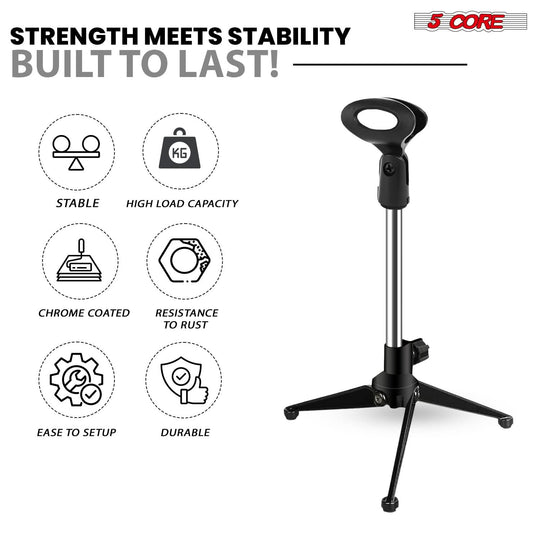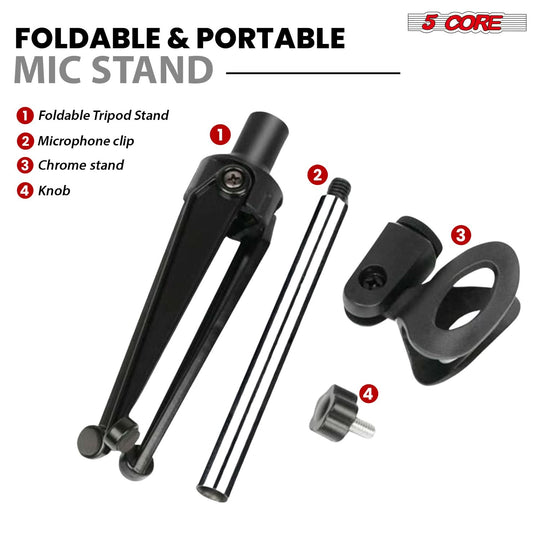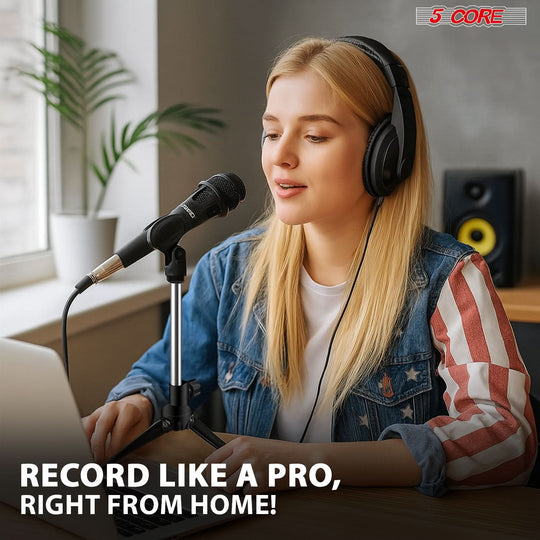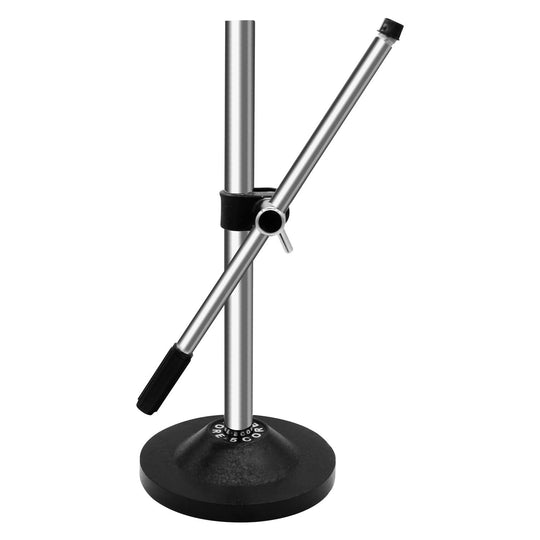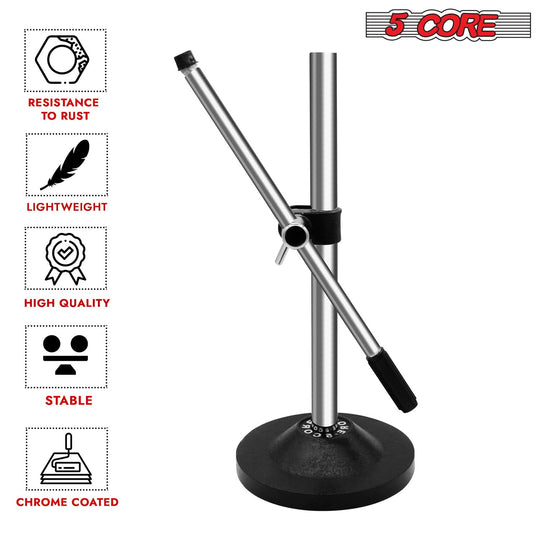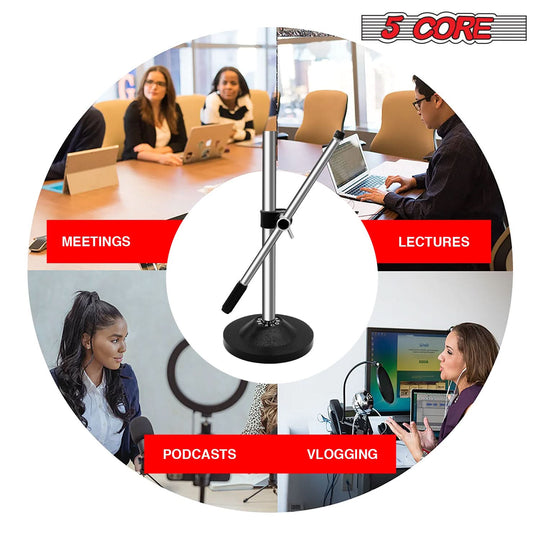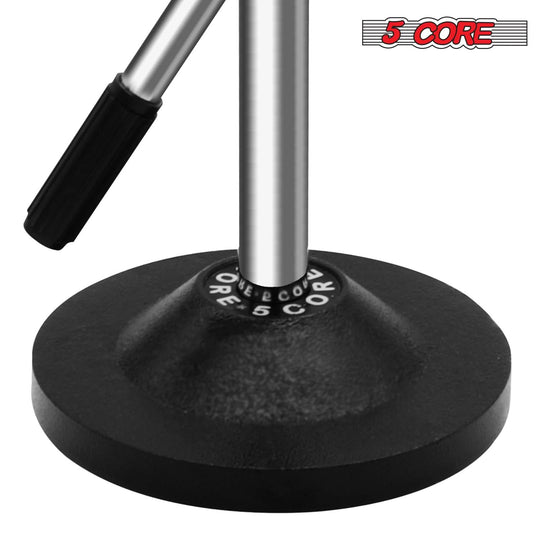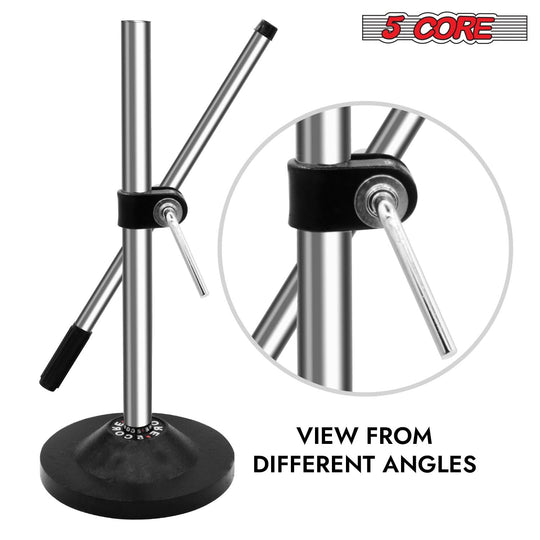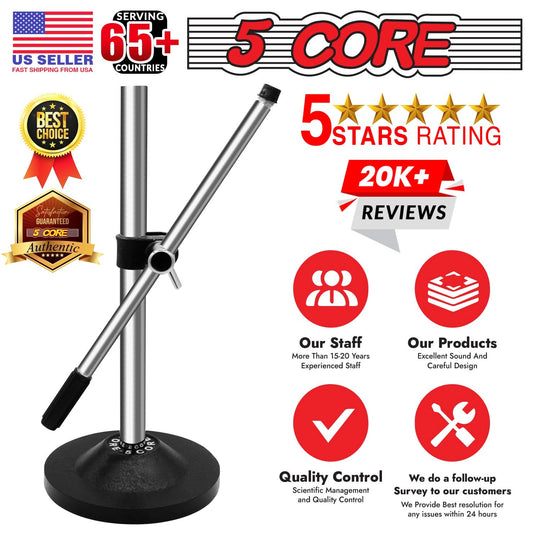Filtrar y ordenar
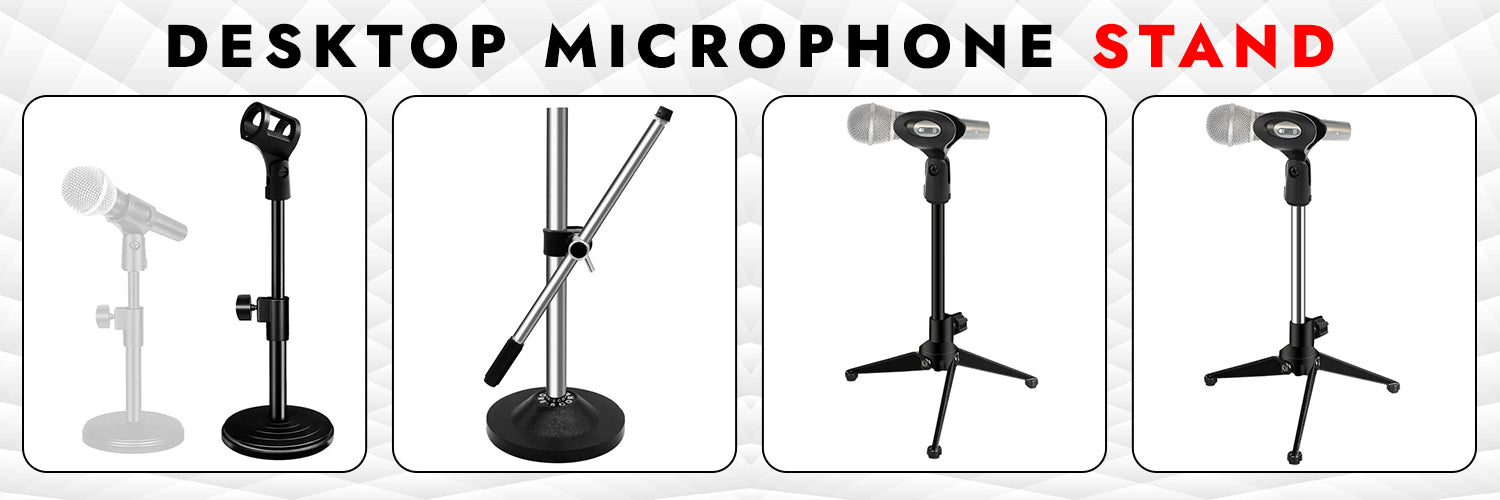
The Ultimate Guide to Desktop Mic Stands
A reliable desktop mic stand isn’t just a simple accessory—it directly affects audio consistency, comfort, workflow, and even long-term microphone health. Whether you’re recording vocals, running a podcast, streaming, or working inside a compact studio, choosing the right mic stand desk setup ensures cleaner sound and a smoother creative process. This guide breaks down every detail you must know before buying a desktop microphone stand from the 5 Core Tripod Collection.
Types of Desktop Microphone Stands – Complete Breakdown
Choosing the right type of desktop microphone stand is one of the most overlooked decisions in setting up a clean, reliable, and comfortable recording space. Each design solves specific problems related to stability, desk space, microphone weight, camera framing, and workflow. Here’s everything you need to know to pick the perfect one for your setup.
1. Tripod Desk Mic Stand
The classic three-legged stand that remains the go-to choice for most creators.
Key Strengths
-
Highly versatile and portable — folds flat and fits in most backpacks
-
Works flawlessly with dynamic, condenser, and lighter broadcast microphones
-
360° access around the microphone, making it perfect for interviews and round-table podcasts
-
Adjustable height in most models (typically 5–15 inches)
Ideal For
-
Home studios, podcast tables, mobile recording rigs, and multi-person interviews
-
Anyone who frequently moves their setup between locations
Things to Watch
-
Legs can transmit keyboard or desk vibrations if not placed on a soft mat
-
Takes up central desk space, which can interfere with mouse/keyboard use during long sessions
2. Weighted-Base (Round-Base) Desk Microphone Stand
A short, heavy circular base with minimal or no height adjustment — built purely for rock-solid stability.
Key Strengths
-
Exceptional vibration isolation and almost impossible to tip over
-
Minimal desk footprint — slides easily under monitors or keyboards
-
Dramatically reduces table resonance and handling noise, delivering cleaner recordings
Ideal For
-
Permanent podcast or video desks where the seating position rarely changes
-
Heavy broadcast microphones that would overwhelm lighter stands
-
Setups where a clean, uncluttered on-camera look is priority
Things to Watch
-
Fixed or limited height means your chair and desk height must be perfectly matched to the mic
3. Adjustable Boom Table Mic Stand (Scissor or Articulating Arm)
A clamp- or grommet-mounted arm that extends the microphone over the desk and positions it exactly where you need it.
Key Strengths
-
Completely frees up desk surface area for keyboards, mice, notes, or controllers
-
Precise, repeatable positioning — perfect on-axis placement every time you sit down
-
Keeps the microphone out of the camera frame for streamers and video creators
-
Built-in cable management channels in higher-end models
Ideal For
-
Gaming and streaming stations
-
Multi-monitor workstations
-
Reading long scripts or voice-over work without leaning forward
-
Multi-guest podcasts where the mic needs to swing between speakers
Things to Watch
-
Lower-cost arms can sag over time with heavier microphones
-
Requires a sturdy desk edge (at least 2–3 inches thick for most clamps)
4. Mini Table Mic Stand
Ultra-compact stands designed for maximum portability and tiny workspaces.
Key Strengths
-
Extremely lightweight and small — easily fits in a laptop bag
-
Perfect for travel recording, field interviews, or very cramped desks
-
Quick setup and teardown
Ideal For
-
Mobile journalists, traveling podcasters, and laptop-based creators
-
Temporary or secondary microphone positions (e.g., laptop webcam calls, quick voice memos)
-
Situations where full-size stands are simply too big
Things to Watch
-
Limited height and stability — not suitable for heavy microphones or permanent setups
-
More prone to picking up typing or surface noise due to lighter construction
Quick Selection Guide
-
Need portability and flexibility → Tripod
-
Need maximum stability and vibration rejection → Weighted-Base
-
Need total desk space and perfect positioning → Adjustable Boom Arm
-
Need the smallest possible footprint for travel → Mini Table Stand
Match the stand type to your actual workflow and environment, and you’ll instantly notice smoother sessions, fewer audio issues, and less physical strain — without ever having to think about your stand again.
Common Table Mic Stand Failures & Permanent Fixes
After repairing thousands of broken stands and listening to countless horror stories, these are the seven failures that destroy 95 % of cheap and mid-tier mic stands within 6–18 months. Here’s exactly why they happen and the permanent, one-time fixes that pros use so they never deal with them again.
-
Slow Sag / Drooping Arm Why it happens: Weak or exposed springs lose tension, cheap threaded joints loosen, low weight rating. Permanent fix: Use an arm rated for at least 1.5× your total mic + accessories weight and that uses internal (hidden) springs or gas pistons. Once tension is strong enough from day one, it will hold position for 5–10 years without adjustment.
-
Base Wobble or Tipping (Tripod & Round-Base) Why it happens: Plastic base, hollow metal, or under 4 lb total weight. Permanent fix: Choose a full cast-iron or steel base that weighs at least 6–8 lb (round-base) or metal tripod legs with a weighted center disc. A stand that heavy simply refuses to tip or rock, even when you swing the arm fast.
-
Clamp Crushing or Slipping Off the Desk Why it happens: Thin plastic clamp pads, weak C-clamp screw, or clamp opening too small for thick desks. Permanent fix: Get a clamp with metal-reinforced jaws, rubber or cork pads on both sides, and a minimum 2.5-inch opening. Add a $3 desk-edge protective strip (felt or silicone) and tighten once with a proper wing nut — it will never move again.
-
Plastic Thread Stripping at the Mic Mount Why it happens: Cheap 5/8″ plastic threads strip the first time you over-tighten or swap shockmounts. Permanent fix: Insist on all-metal 5/8″ threads with brass inserts. They never strip, even after 500 swaps.
-
Spring Creak & Cable Rattle Noise in Recordings Why it happens: Exposed springs rub, cables slap inside hollow arms. Permanent fix: Buy an arm with fully enclosed springs and integrated cable channels. One proper routing on day one = zero noise forever.
-
Height / Angle Knob Keeps Loosening Why it happens: Tiny plastic wing nuts or friction-only joints. Permanent fix: Look for large metal star knobs or cam-lock levers that bite hard. Tighten once with moderate hand pressure and they stay locked for years.
-
Sudden Catastrophic Collapse (The $800 Microphone Killer) Why it happens: Fatigue failure in a cheap pot-metal joint or a $29 arm pushed past its real limit. Permanent fix: Never buy a stand that costs less than your weekly coffee budget if you’re putting a $300+ mic on it. Invest once in a 5–10-year-rated metal arm from a company that actually warranties it. One good stand costs less than one replacement Mic.
Do these seven things right when you buy your next stand and you will literally never have to think about mic stand problems again. Most creators learn this the hard way after their mic has already hit the floor once. Do it right the first time and skip the heartbreak.
How to Buy a Table Mic Stand — A Pro Guide
1. Understand What You Really Need
First, clarify how you're going to use the stand: podcasting, streaming, music recording, voice-overs, or simple desk calls.
-
Evaluate your workspace: is your desk small or large? Do you move your mic a lot while working? These determine which type of desktop mic stand to pick.
-
Consider the vibration factor: desktop stands sit directly on the desk, so if your desk picks up a lot of keyboard or mouse noise, you’ll need something with a good base or isolation.
2. Check Mic Compatibility (Thread Size + Weight)
-
Most mic stands use standard threaded mounts, typically 3/8″ or 5/8″. You need to make sure your mic’s mount is compatible, or that you have the right adapter.
-
The weight capacity of the stand is very important: heavier microphones (especially broadcast mics or large condensers) require a stand with a strong base or heavier construction so they don’t tip over.
-
If you’re using shock mounts or pop filters, also account for their weight; a stand that works for just the mic may not hold up when these are added.
3. Prioritize Build Quality and Stability
-
Choose stands made of metal (steel or aluminum) rather than cheap plastic—they’re more durable and stable.
-
Check the base: a weighted base (metal cast or dense material) offers much better stability than a flimsy or unweighted one.
-
Rubber or non-slip feet under the base help absorb vibration from desk bumps and prevent sliding.
4. Think About Adjustability and Flexibility
-
Adjustable-height stands let you place the mic precisely. Look for telescoping shafts or joints that can lock well.
-
If you need to move your mic around while working (e.g., between talking, keyboarding, or singing), consider a gooseneck or boom-style desktop stand. These let you angle or reposition the mic easily.
For very flexible positioning, check if the stand allows swivel or tilt.
5. Evaluate Noise Isolation Capability
-
Desk vibrations are common: to minimize them, good stands either include or support shock mounts, or have dampening materials (rubber feet, vibration-resistant base) to isolate the mic.
-
Some stands may have built-in features for isolation (or the design inherently helps).
6. Desk Space and Portability
-
For tight desks, a stand with a compact base is better.
-
If you're going to move the stand or travel, consider a foldable or lightweight tripod desktop stand.
-
If you want to avoid taking up desk real estate, a boom arm (clamped) may be more space-efficient—and is often recommended for more flexible / professional setups.
7. Long-Term Durability
-
Prefer quality manufacturing: strong joints, good metal finish, and a stable base means your stand will last many years.
-
Check user reviews or spec sheets for durability.
Maintenance matters: make sure you can tighten or adjust parts over time.
FAQ – Desktop Microphone Stands
Question: Which desk mic stand is best for podcasting?
Answer: A tripod or weighted-base podcast mic stand with adjustable height works best for spoken audio.
Question: Can a desktop mic stand hold heavy broadcast microphones?
Answer: Yes, as long as the stand has a solid metal base and reinforced structure. 5 Core stands are designed for heavy mics.
Question: Are tripod table mic stands stable?
Answer: Modern tripod table mic stand designs with rubber feet are extremely stable and reduce desk vibration.
Question: What height should my mic stand desk setup be?
Answer: The mic should sit roughly at mouth level to ensure consistent vocal pickup.
Question: Do desktop mic stands work for live streaming?
Answer: Absolutely—especially boom-style stands that keep the mic close without blocking your face.
Question: Do I need a shock mount with a desktop microphone stand?
Answer: A shock mount isn’t mandatory, but it’s highly recommended if your desk is prone to vibrations, typing noise, or accidental bumps.
Question: Are gooseneck desk mic stands good for recording vocals?
Answer: Yes, gooseneck stands offer excellent angle control for vocal recording, but they’re best suited for lightweight microphones.
Question: What thread size do most desktop microphone stands use?
Answer: Most stands use 5/8-inch threads and often include a 3/8-inch adapter for universal microphone compatibility.
Question: Can I use a desktop mic stand for gaming and Discord calls?
Answer: Yes—desktop stands keep the mic close to your mouth, improving clarity for gaming chat, livestreams, and calls.
Question: Will a desktop mic stand damage my table surface?
Answer: Quality stands have rubberized, non-slip bases that protect your desk from scratches while reducing noise transmission.
Question: How do I stop my mic stand from tipping over?
Answer: Use a weighted-base stand, avoid overextending the boom, and ensure the microphone is centered above the base.
Question: Are desktop stands better than clamp-on boom arms?
Answer: Desktop stands are more stable, easier to set up, and ideal for heavy mics. Boom arms save desk space and offer more reach—your choice depends on setup style.
Question: Can a desktop mic stand be used with an audio interface?
Answer: Yes, the stand simply holds the microphone. Compatibility depends on the mic, not the audio interface.
Question: Do desktop mic stands help reduce plosives?
Answer: Not directly, but placing the mic at the correct height and pairing it with a pop filter significantly reduces plosive sounds.
Question: How portable are small table mic stands?
Answer: Mini tripod and collapsible models are extremely portable and fit easily into backpacks, gear bags, or field recording kits.
Question: Can I mount cameras or accessories on a desktop mic stand?
Answer: Some stands support adapters for small cameras, lighting, or accessories—but check weight specs before doing so.
Question: How often should I maintain or tighten my desk microphone stand?
Answer: A quick check every few weeks keeps joints secure and prevents long-term wear, especially if you adjust the stand frequently.
Conclusion
Choosing the right desk mic stand is one of the most important decisions for achieving clean, consistent, and professional audio. Whether you need maximum stability, extended reach, or compact portability, understanding the build quality, weight capacity, and design features helps you select a stand that truly supports your workflow. The 5 Core desktop mic stand collection is engineered with real-world studio experience—using reinforced metal construction, reliable joints, anti-vibration bases, and creator-focused adjustability. These stands deliver long-term durability and performance trusted by musicians, podcasters, and content creators across the industry.
Explore the full 5 Core lineup to get a microphone desk stand that elevates your sound, improves comfort, and keeps your setup ready for every session.
Author Bio-
Alex Even
Hi, I’m Alex Even. I’ve been working in the pro audio industry for over 15 years, specializing in everything from studio recording setups to live sound systems. Whether it’s fine-tuning a PA DJ system, choosing the right microphone, drum stool, keyboard bench or setting up a home studio, karaoke setup, I’ve spent years helping musicians, audio engineers, and content creators get the sound they’re looking for. I’m passionate about making audio technology easy to understand and even easier to use—because great sound should be accessible to everyone.






